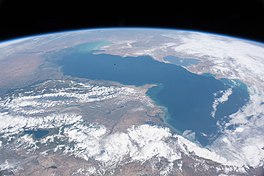
Back Kaspiese See Afrikaans Kaspisches Meer ALS Каспий талай ALT ካስፒያን ባሕር Amharic Mar Caspia AN Caspia ANG Okwaan̄ Kasipian ANN بحر قزوين Arabic ܝܡܐ ܕܐܝܒܪܝܐ ARC بحر قزوين ARZ
| Caspian Sea | |
|---|---|
| Talysh: Káspi dyjo, Latin: Caspium mare, Azerbaijani: Xəzər dənizi, Turkmen: Hazar deňizi, Kazakh: Каспий теңізі, Russian: Каспийское море, Persian: دریای کاسپین | |
 The Caspian Sea taken from the International Space Station, seen from the southwest | |
| Location | Eastern Europe, West Asia, and Central Asia |
| Coordinates | 42°00′N 50°30′E / 42.0°N 50.5°E |
| Type | Ancient lake, Endorheic, saline, permanent, natural |
| Primary inflows | Volga River, Ural River, Kura River, Terek River, Haraz River, Sefid-Rud |
| Primary outflows | Evaporation, Kara-Bogaz-Gol |
| Catchment area | 3,626,000 km2 (1,400,000 sq mi)[1] |
| Basin countries | Iran, Azerbaijan, Kazakhstan, Turkmenistan, Russian Federation (specifically Astrakhan Oblast, Dagestan and Kalmykia) |
| Max. length | 1,030 km (640 mi) |
| Max. width | 435 km (270 mi) |
| Surface area | 371,000 km2 (143,200 sq mi) |
| Average depth | 211 m (690 ft) |
| Max. depth | 1,025 m (3,360 ft) |
| Water volume | 78,200 km3 (18,800 cu mi) |
| Residence time | 250 years |
| Shore length1 | 7,000 km (4,300 mi) |
| Surface elevation | −28 m (−92 ft) |
| Islands | 26+ |
| Settlements | Baku (Azerbaijan), Bandar-e Anzali (Iran), Aqtau (Kazakhstan), Makhachkala (Russia), Türkmenbaşy (Turkmenistan) (see article) |
| References | [1] |
| 1 Shore length is not a well-defined measure. | |
The Caspian Sea is the world's largest inland body of water, described as the world's largest lake and usually referred to as a full-fledged sea.[2][3][4] An endorheic basin, it lies between Europe and Asia: east of the Caucasus, west of the broad steppe of Central Asia, south of the fertile plains of Southern Russia in Eastern Europe, and north of the mountainous Iranian Plateau. It covers a surface area of 371,000 km2 (143,000 sq mi) (excluding the highly saline lagoon of Garabogazköl to its east), an area approximately equal to that of Japan, with a volume of 78,200 km3 (19,000 cu mi).[5] It has a salinity of approximately 1.2% (12 g/L), about a third of the salinity of average seawater. It is bounded by Kazakhstan to the northeast, Russia to the northwest, Azerbaijan to the southwest, Iran to the south, and Turkmenistan to the southeast. The name of the Caspian sea is derived from the ancient Iranic Caspi people.
The sea stretches 1,200 km (750 mi) from north to south, with an average width of 320 km (200 mi). Its gross coverage is 386,400 km2 (149,200 sq mi) and the surface is about 27 m (89 ft) below sea level. Its main freshwater inflow, Europe's longest river, the Volga, enters at the shallow north end. Two deep basins form its central and southern zones. These lead to horizontal differences in temperature, salinity, and ecology. The seabed in the south reaches 1,023 m (3,356 ft) below sea level, which is the third-lowest natural non-oceanic depression on Earth after Baikal and Tanganyika lakes.
With a surface area of 371,000 square kilometres (143,000 sq mi), the Caspian Sea is nearly five times as big as Lake Superior (82,000 square kilometres (32,000 sq mi)).[6] The Caspian Sea is home to a wide range of species and is famous for its caviar and oil industries. Pollution from the oil industry and dams on rivers that drain into it have harmed its ecology. It is predicted that during the 21st century, the depth of the sea will decrease by 9–18 m (30–60 ft) due to global warming and the process of desertification, leading to an ecocide.[7][8][9]
- ^ a b van der Leeden, Troise, and Todd, eds., The Water Encyclopedia. Second Edition. Chelsea F.C., MI: Lewis Publishers, 1990, p. 196.
- ^ "Convention on the Legal Status of the Caspian Sea". President Of Russia. 12 August 2018. Archived from the original on 12 March 2022. Retrieved 22 January 2022.
- ^ "Is the Caspian a sea or a lake?". The Economist. 16 August 2018. ISSN 0013-0613. Archived from the original on 19 August 2018. Retrieved 22 January 2022.
- ^ Zimnitskaya, Hanna; von Geldern, James (1 January 2011). "Is the Caspian Sea a sea; and why does it matter?". Journal of Eurasian Studies. 2 (1): 1–14. doi:10.1016/j.euras.2010.10.009. ISSN 1879-3665. S2CID 154951201.
- ^ Leong, Goh Cheng (27 October 1995). Certificate Physics And Human Geography; Indian Edition. Oxford University Press. p. 66. ISBN 978-0-19-562816-6. Archived from the original on 16 October 2022. Retrieved 17 January 2022.
- ^ "Great Lakes – Physical Facts". United States Environmental Protection Agency. Archived from the original on 29 October 2010. Retrieved 1 January 2023.
- ^ Dumont, Henri (October 1995). "Ecocide in the Caspian Sea". Nature. 377 (6551): 673–674. Bibcode:1995Natur.377..673D. doi:10.1038/377673a0. ISSN 1476-4687. S2CID 4363852.
- ^ Wesselingh, Frank; Lattuada, Matteo (23 December 2020). "The Caspian Sea is set to fall by 9 metres or more this century – an ecocide is imminent". The Conversation. Retrieved 29 June 2023.
- ^ Cite error: The named reference
:2was invoked but never defined (see the help page).



